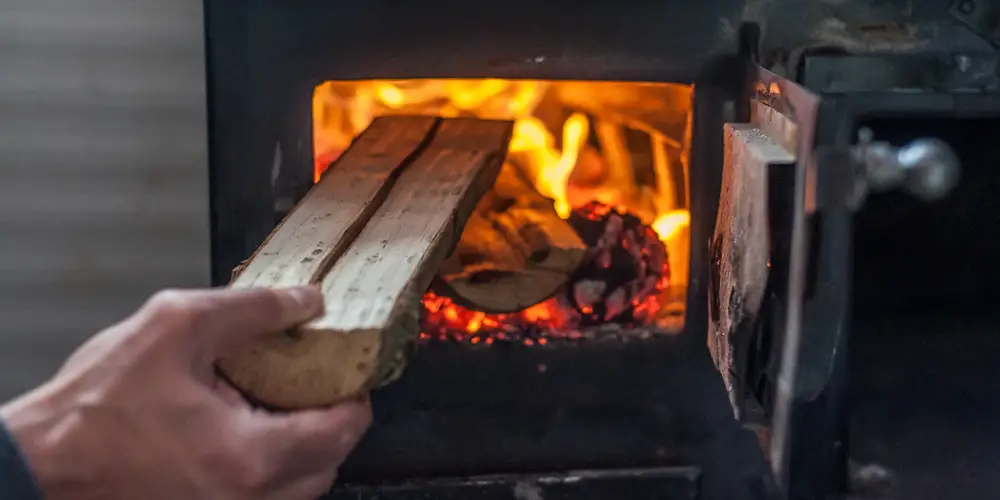Wood-burning stoves have gained popularity as a source of cozy warmth, but their environmental impact raises important questions about their true eco-friendliness.
Wood-burning stoves are a cleaner alternative to multi-fuel stoves that burn fossil fuels. A modern EcoDesign wood stove is up to 90% efficient, depending on the quality of the stove, and the type of wood burned. The efficiency of the appliance also depends on the way you use it.
Curious to discover the full picture on the environmental friendliness of wood-burning stoves? Read on to find out more!

Is a wood-burning stove bad for the environment?
Wood is usually considered a greener alternative to fossil fuels, in part because wood is a renewable source of energy. The amount of carbon a tree absorbs from the atmosphere is the same as the amount released when the tree is burned or decomposed.
There is another reason why many environmentalists consider wood a safer alternative to fossil fuels: the remarkable technological developments of wood-burning stoves. Modern, sophisticated wood stoves have very low emissions compared with the fireplaces and wood stoves of old days.
Taking these factors into consideration, governments around the world are now offering subsidies for using modern wood-burning stoves. This has led to an increase in wood burning in many developed countries.
At the same time, authorities are encouraging homeowners to use their wood stoves responsibly, because the emissions of smoke largely depend on the way these appliances are used. There are specific regulations for installing wood-burning stoves.
Do wood-burning stoves cause indoor air pollution?
The combustion of wood releases pollutants such as carbon dioxide, carbon monoxide, nitrogen oxides, formaldehyde, volatile compounds and fine particulate matter that affect indoor quality. However, it is important to note that the quality of indoor air is affected by many other acts such as lighting candles, cooking with gas, dusting, vacuuming, and using aerosols.
The impact largely depends on the wood-burning stove being used. Modern catalytic and non-catalytic wood stoves are remarkably more efficient than older models. EcoDesign wood stoves are up to 90% efficient, and emit little to no smoke.
While open fires can pollute the air and thus contribute to some health issues, no such dangers are associated with modern wood-burning stoves. One study found that homes with non EPA-certified wood-burning stoves have significantly higher levels of combustion-related pollutants than homes with EPA-certified stoves.
Some researchers even suggest that an efficient wood-burning stove can actually improve the indoor air quality by drawing air from the room.

Is wood a carbon-neutral fuel?
The combustion of 1 kg of wood releases between 1.65 and 1.80 kg of CO2. The exact amount depends on factors such as the species and age of wood. However, Wood is carbon-neutral in the long term because the process of combustion does not increase the total amount of CO2 in the atmosphere.
Whether a tree is burned or decomposed, the amount of CO2 the tree has absorbed in its lifetime is released back into the environment—a process that represents the completion of the carbon cycle.
Of course, forest biomass is carbon-neutral on long time scales only. And wood is a sustainable source of energy only if we preserve forests by growing new trees. While there is an ongoing debate regarding this issue, it is pretty well-established that unlike fossil fuels, forest biomass can be a sustainable source of energy.
The combustion of wood definitely has an adverse impact on the environment unless reforestation is taken seriously.
How can I reduce pollution from wood-burning stoves?
The good news is, you can significantly reduce emissions by making small changes in the way you use your wood-burning stove. Here are a few tips to follow when using your stove:
- Use an efficient stove: The current laws in the UK and USA allow you to keep using your old wood-burning stove, but manufacturers can no longer sell stoves of older models. Replacing an old stove with a new catalytic or non-catalytic stove is a surefire way to reduce your carbon footprint. This investment can also help you save money in the long term.
- Burn seasoned wood only: Make sure the wood you burn has a moisture content of 20% or less. If the wood is insufficiently seasoned, the combustion will produce more smoke. Buy firewood with a Ready to Burn logo. You can use a moisture meter to measure the moisture content of the wood. Wet wood is not only inefficient but also increases the risks of chimney fires and carbon monoxide poisoning.
- Burn large fires: When operating the stove, make sure it has a visible flame. Setting the appliance to burn at a low level will exponentially increase emissions. Slow combustion creates more creosote that can cause fire hazards. A crackling flame can also make your space cozier.
- Do not completely close the air supply: The stove will emit Large amounts of volatile compounds due to insufficient air supply. But if the air vents are wide open, the fire will burn too fast. Once the stove is hot, you do not necessarily have to adjust the air supply. Just keep adding small amounts of wood at regular intervals.
- Ensure proper maintenance: Check the gaskets and remove the ashes regularly. Sweep the chimney and clean the stove pipe once in a while. If there is a residue buildup, clean it to prevent poor draught.
What are the advantages of modern wood-burning stoves?
There are mainly two types of modern wood-burning stoves (Link to the article “Types of wood-burning stove) : catalytic and non-catalytic. Catalytic stoves, which are a bit expensive, emit little to no smoke while non-catalytic stoves emit slightly more smoke. However, both of them are better than the basic wood stoves of old days.
In the EU, all wood-burning stoves sold by manufacturers must meet a standard called EcoDesign. The mandate, which aims to reduce harmful emissions, has been in effect since 1 January 2022. According to the regulations, an EcoDesign stove must have a seasonal efficiency of at least 65%.
The main advantage of using an EcoDesign stove is that it emits fewer particulate matter, and that’s good for health and the environment. When you use properly seasoned wood with a moisture content of less than 20%, an EcoDesign stove emits up to 90% less particulate matter than an open fire does.
This appliance also requires less wood to produce heat, and thus significantly cuts fuel costs. That means, you can reduce your carbon footprint and save money in the long term by just investing in an EcoDesign stove.
In the USA, you may receive government incentives for replacing your old stove with an EPA-certified wood-burning stove. Not every state has a changeout program, but the government has taken some pragmatic steps to reduce the environmental impact of wood burning.

Conclusion
Wood is a remarkably greener alternative to fossil fuels, but it still has significant environmental impact. You can reduce this impact by replacing your old stove with a new, efficient unit.
But buying a modern wood-burning stove is not enough. You must use seasoned wood, operate your stove properly, and ensure its maintenance. As long as you use it responsibly, a wood-burning stove can be an environmentally friendly appliance.
